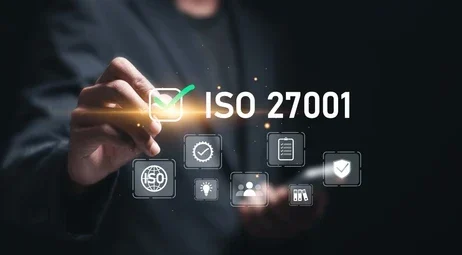
ISO 27001 is a globally recognized standard that defines the requirements for establishing, implementing, maintaining, and continually improving an ISMS within an organization. This comprehensive framework is designed to help organizations systematically manage information security risks and ensure the confidentiality, integrity, and availability of critical information.
Within the ISO 27001 standard, there are a total of 97 controls organized into various domains, including:
These controls, distributed across these domains, collectively serve as a robust framework for organizations to safeguard their information assets and mitigate security risks in an ever-evolving digital landscape.
Confidentiality
Confidentialitytranslates to data and systems that must be protected against unauthorized access from people, processes, or unauthorized applications. This involves use of technological controls like multifactor authentication, security tokens, and data encryption.
Confidentiality means only the right people can access the information held by the organization.
Integrity
Integrity means verifying the accuracy, trustworthiness, and completeness of data. It involves use of processes that ensure data is free of errors and manipulation, such as ascertaining if only authorized personnel has access to confidential data.
Information integrity means data that the organization uses to pursue its business or keep safe for others is reliably stored and not erased or damaged.
Availability
Availability typically refers to the maintenance and monitoring of information security management systems (ISMSs). This includes removing any bottlenecks in security processes, minimizing vulnerabilities by updating software and hardware to the latest firmware, boosting business continuity by adding redundancy, and minimizing data loss by adding back-ups and disaster recovery solutions..
➢ Kick-off meeting: A kick-off meeting will be held to initiate the project and align on objectives.
➢ Define ISMS scope and boundaries: The scope and boundaries of the Information Security Management System (ISMS) will be clearly defined with he help of the clients’ inputs.
➢ Project steering committee: A project steering committee will be established to oversee the project’s progress and decision-making.
➢ Roles, responsibilities, and authorities: Roles, responsibilities, and authorities for team members will be outlined to ensure clear accountability and effective management.
➢ Project timeframes: We will provide a Project timeframe which’ll be outlining the scheduled duration for completing various phases of the project.
➢ Project plan: A Project plan will shared, detailing the overall strategy and steps needed to achieve the project’s objectives.
➢ Approach, methodology: INFOCUS IT’s Approach and methodology will define the strategies and techniques used to tackle project tasks and challenges.
➢ Introductory workshop: A virtual Introductory workshop would be conducted for an initial overview and orientation to set the stage for the project’s execution.
➢ Gap Analysis: Gap Analysis would help in identifying discrepancies between current practices and desired standards or requirements in the organization.
➢ Review of existing policies: This will help in evaluating current policies to determine their alignment with required standards and best practices.
➢ Gap analysis report: We’ll provide a detailed account of the identified gaps, including recommendations for bridging or clients to achieve compliance.
➢ Information asset inventory: This will help in establishing a comprehensive list of all information assets, detailing their types, locations, and owners of the organization.
➢ Information asset management framework: We will provide a structured approach for managing and protecting information assets throughout their lifecycle, ensuring they are appropriately secured and utilized.
➢ Asset registers: INFOCUS IT will provide you with a detailed records of information assets, including their classification, value, and risk level, to support effective management and protection.
➢ Risk Assessment methodology: Our risk assessment methodology outlines the approach used to identify, analyze, and evaluate risks within the organization.
➢ Criteria for risk treatment and acceptance: Criteria for risk treatment and acceptance would be defined on the basis of the standards.
➢ Risk assessment framework: INFOCUS IT’s risk assessment framework provides the structured process and tools for conducting risk assessments and ensuring comprehensive risk management.
➢ Identification and evaluation for risk treatment plans: Identification and evaluation for risk treatment plans involves determining the necessary actions to address and mitigate risks, followed by evaluating the effectiveness of these plans.
➢ Selection of control objectives and controls: We help in determining the specific goals and security measures needed to mitigate identified risks and ensure compliance with risk management requirements.
➢ Risk Assessment Report: INFOCUS IT provides the Risk Assessment Report which includes the findings from the risk assessment process, including identified risks, their potential impacts, and the proposed risk treatment strategies.
➢ Control objectives & controls: Outline the specific goals for protecting information and the measures implemented to achieve them.
➢ Documentation of identified Risk: Detail the risks that have been identified and documented, including their potential impact and the strategies to address them.
➢ Statement of Applicability (SOA): Define how the principles of confidentiality, integrity, and availability are applied, ensuring that sensitive information remains protected, accurate, and accessible as required.
➢ Review /Design existing policies and procedures: Evaluating and refining current policies and procedures to ensure they meet the necessary standards and requirements.
➢ Design of policies, procedures, and guidelines: We create new policies, procedures, and guidelines to address identified needs and enhance organizational practices.
➢ Submission of Documents for review & approval: Present the developed policies and procedures to relevant stakeholders for review and formal approval.
➢ Training sessions: Offer a comprehensive overview of essential topics, ensuring participants are well-versed in key concepts and practices.
➢ ISO basics: Cover fundamental principles and standards of ISO 27001, providing a solid foundation for understanding information security management.
➢ Risk Assessment: Equip participants with the basic knowledge to identify, evaluate, and prioritize risks to effectively manage and mitigate potential threats.
➢ Internal Audit: Teach the processes and techniques for conducting thorough internal audits to assess compliance and effectiveness of information security controls.
➢ Audit checklist preparation: Development of detailed checklists to ensure all relevant aspects of the ISO 27001 standard are covered during audits.
➢ Audit report writing: Crafting clear, comprehensive, and actionable audit reports that communicate findings and recommendations effectively.
➢ Internal audits (IT, Operations, Legal, Finance): Internal audits are conducted across various departments including IT, Operations, Legal, and Finance to evaluate the effectiveness of controls and compliance with established policies and regulations.
➢ Internal Audit report: The audit report provides a comprehensive assessment of the audit findings, highlighting areas of strength, identifying weaknesses, and recommending improvements to ensure robust governance and risk management.
➢ Management review meetings: Evaluate the effectiveness and alignment of the Information Security Management System (ISMS) with organizational goals and policies.
➢ Corrective action plan: Develop and implement strategies to address identified issues or non-conformities within the ISMS.
➢ Review of implemented controls: Assess the effectiveness and efficiency of security controls that have been put in place to protect information assets.
➢ Continual Improvement plan: Identify and implement opportunities for enhancing the ISMS to better manage and mitigate information security risks.
➢ Review of ISMS Dashboard: Monitor and analyze key metrics and performance indicators related to the ISMS to ensure it meets its objectives and supports overall security strategy.
➢ Readiness checks for final (External) audit: Conduct thorough checks to confirm fully preparedness for the final audit by an external body.
➢ Stage1 Audit: Perform a preliminary audit to assess your initial compliance and identify any areas that require improvement before the main audit.
➢ Stage 2 Audit: Execute the main audit to verify the implementation and effectiveness of your information security management system.
➢ Closure of Gaps given by External Body: Address and resolve any issues or gaps identified by the external audit to ensure successful certification.
➢ ISO27001:2022 Certified: Achieve certification under ISO 27001:2022, demonstrating your commitment to robust information security management
➢ Start again from stage: This involves reviewing the ISO 27001 ISMS again from the initial stage of the audit process, including a reassessment of the scope, objectives, and key areas of focus to ensure ongoing compliance and effectiveness.
The advantages realized by our clients would include:
Your Questions, Our Solutions
support@infocus-it.com
91-8178210903, 91-9266047050
A-19, Yadav Park, Rohtak Road, Behind Bank of Baroda, West Delhi-110041, India
Your trusted partner in comprehensive cybersecurity solutions. Protecting your data, securing your networks, and ensuring compliance with industry standards. Stay ahead of threats with our expert team.
Call us – 91-8178210903
91-9266047050
or write
support@infocus-it.com

© 2024 INFOCUS IT CONSULTING PVT. LTD.